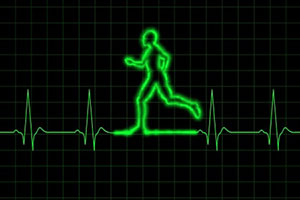![]()
Blog @ SunTech
Advice from the BP Measurement Experts
3 Types of Stress Tests: Part 1 of 2 - The ETT
 Have you ever been to your doctor’s office and wondered why one type of test was ordered over another? And, if they are all important, what makes a doctor ask for that particular type of test? Well when it comes to stress testing there are many different types of tests but generally they all come down to 3 different types. If your doctor orders you to have a stress test this can mean that you are having a cardiac or exercise stress test (often called an ETT or an exercise treadmill test), an echocardiogram stress test (often called Stress ECHO), or a nuclear stress test (often called a Walking Nuc or Nuc Test).
Have you ever been to your doctor’s office and wondered why one type of test was ordered over another? And, if they are all important, what makes a doctor ask for that particular type of test? Well when it comes to stress testing there are many different types of tests but generally they all come down to 3 different types. If your doctor orders you to have a stress test this can mean that you are having a cardiac or exercise stress test (often called an ETT or an exercise treadmill test), an echocardiogram stress test (often called Stress ECHO), or a nuclear stress test (often called a Walking Nuc or Nuc Test).
We have found that the type of test ordered is determined by your heart’s health or by your physical condition. In our 2 part blog series we will try to answer these questions about why one test can be used over another, what your doctor may be looking for during this test, and what parameters they look at during the test.
The ETT
A cardiac or exercise treadmill test is the least invasive because it does not require additional medical devices other than an ECG stress system and a treadmill or ergometer. The total time for this test is about 45 minutes. In this test you will be asked to walk on a treadmill or bike on an ergometer for around 15 minutes, generally using the Bruce Protocol. This protocol was developed to get your heart working harder and beating faster as you move through the stages of the protocol. Your doctor will calculate your maximum heart rate using one of the following equations:
Male Maximum Heart Rate = 200 – patient’s age
Female Maximum Heart Rate = 206 – (0.88 x patient’s age)
You will be connected to a 12 lead ECG stress system so that your doctor can monitor the heart’s activity, or more importantly, the ECG waveforms that will provide the doctor information about your heart’s health! This connection is important because the information that is provided can help diagnose a large variety of potentially life threatening heart conditions, such as myocardial infarction or arrhythmias. Heart rate (HR) and blood pressure (BP) are also continually monitored to ensure that these do not reach dangerous levels. Having one of these parameters reach a high level such as the BP reaching 220/109 would provide the doctor with additional clues as to your heart’s condition.
You may have noticed that I talked about using a treadmill or a cycle ergometer during your stress test. This is usually determined by where you live on the globe. Generally speaking treadmills are more commonly used in countries such as the United States, Mexico, Canada, England, Australia, Greece, and China whereas ergometers are more common in Japan, France, Ukraine, Russia, Netherlands, and Africa. However, when it comes to stress testing, many of the countries that have ergometers are moving to treadmills.
Now, why would this be important and what is the difference? The difference is in what the doctor wants to get out of the test. Treadmills have clear protocols that the doctors can follow and can be easier for patients that have trouble with balance. Cost can also play a part here – treadmills are more expensive than a cycle ergometer.
Yet some countries, such as Japan, are moving more toward treadmills for some forms of stress testing. This is because of the results that are achieved from the treadmill verses the ergometer are better for stress testing. Treadmills simply work the heart harder which is the main point of a stress test. This is not saying that an ergometer stress test is not challenging or a good measure of the work the heart puts out. It is a good tool for testing. However, they do have limitations that a treadmill doesn’t have. Ergometers are not recommended for patients that have poor coordination, have lower extremity musculoskeletal disease, or are performing a gas exchange study. It has been found that if a patient is prescribed a stress test with the addition of a peak VO2 study, peak O2 pulse study, or anaerobic threshold study, a treadmill will allow a better study.
Though, treadmills are also known for introducing movement artifact into a stress test study. Motion artifacts can affect the measurements of ventilation, pulmonary gas exchange, and blood pressure. With the parameters surrounding a stress test, collecting accurate data the first time is imperative, because who really wants to do a stress test twice? It should be important to you and your physician that automated systems are used to collect your data, such as an automated BP monitor, are used. This will ensure patient safety remains the number one priority in the stress lab.
Continue to "3 Types of Stress Tests: Part 2 of 2 - The ECHO and Nuc"
Citations:
"What Is an Echocardiogram Stress Test?" Cardiac Surgery Associates, S.C.. N.p., 4 June 2010. Web. 15 Aug. 2013. <http://openheart.net/procedures/tests/stressecho.htm>.
"Cardiac Stress Test Using Medicine (1 and 2 Day Imaging)." National Jewish Health. N.p., n.d. Web. 15 Aug. 2013. <http://www.nationaljewish.org/programs/tests/cardiac/cardiac-stress/>.
Wasserman, Karlman, and Etl.. Principles of Exercise Testing and Interpretation, 5th Ed. Philadelphia, PA: Lippincott Williams & Wilkins, 2012. Print.
Thaler, Malcolm S. The Only EKG Book You'll Ever Need, 5th Ed. Philadelphia, PA: Lippincott Williams & Wilkins, 2007. Print.
"Bruce Protocol Stress Test." TopEndSports. N.p., n.d. Web. 25 Sept. 2013. <http://www.topendsports.com/testing/tests/bruce.htm
Interested in getting more SunTech news, product info, as well as
tips, tricks, and insights from BP experts?
Sign up to get fresh content delivered direct to your inbox.



